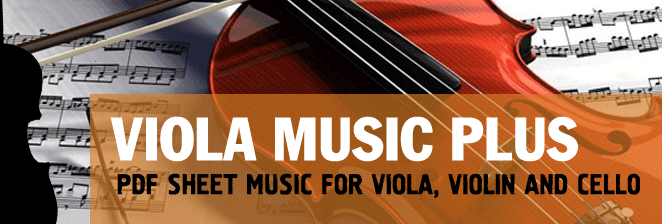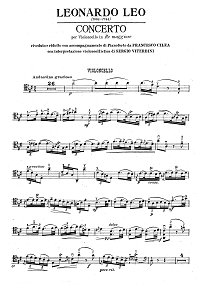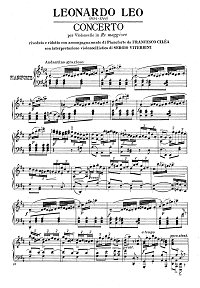|
|
 |
|
| |
| |
Leo - Cello Concerto N2 D-dur
Leo - Cello Concerto N2 D-dur. You can download the PDF sheet music Leo - Cello Concerto D-dur on this page. Leo's D major Cello Concerto takes an expansive five-movement form. As with the previous work, we begin with a slow introduction of clear-textured grace, preceding the injection of energy marked Con bravura, a movement in which substantial demands are made of the soloist's technique in rapid arpeggiac passages. The melancholic slow movement is followed by a fine example of Leo's contrapuntal skill, in the Fuga, before a refined Allegro di molto ends the work.
To download PDF, click the "Download PDF" button below the appropriate sheet music image.
To view the first page of Leo - Cello Concerto D-dur click the music sheet image. |
| PDF format sheet music |
|
|
|
Instrument part: 5 pages. pages. 842 K
|
Piano part: 12 pages. pages. 1561 K
|
 |
 |
|
|
| Download PDF (14.99
€) |
Download PDF (14.99
€) |
|
One of the foremost Neapolitan composers of his time, Leonardo Leo was especially prolific in the realms of opera, theatre and church music. However, his purely instrumental works, as in this collection, are enjoying increasing recognition. Leo first journeyed to Naples in 1709, where he studied with Nicola Fago at the Conservatorio S Maria della Pieta dei Turchini. Within three years his 'drama sacro', S Chiara, o L'infedelta abbattuta, was performed at the conservatorio in 1712, and then again at the viceroy's palace on 14 February of the same year, indicating that the work received an unusual degree of attention for a student composition.
On graduating in the following year, Leo became supernumerary organist at the viceroy's chapel, a post held alongside his new duties as maestro di cappella for the Marchese Stella. Leo produced his first opera in 1714, entitled II Pisistrato, in the wake of which there followed commissions for operatic arrangements, small-scale ensemble works and, in 1718, a second opera. Leo's operatic overtures were in themselves of significance, helping to pave the way for the pre-Classical symphonic style, and from 1720 to his death in 1744 he received a steady stream of opera commissions. Leo was particularly in demand in the field of comic opera - commedia musicale - of which genre he became a celebrated exponent, instilling the comic style with the gravitas of opera seria.
However, Leo's own serious operas met with considerable competition in the form of music by Vinci and Hasse. Neapolitan music during this era was full of rivalry and faction, the 'Neapolitan school' polarised by opposing approaches to composition. Durante was Leo's main rival, both as a teacher and as a promoter of reform in church music. Durante's instinctive approach enjoyed loyal support in the form of the so-called 'Durantisi', who favoured his relative harmonic and melodic freedom. In contrast, Leo's supporters, the 'Leisti', prized his contrapuntal, academic style with its evident ecclesiastical influences. Yet Leo's gift for melody, and his technical accomplishment and versatility, belie the difficulty with which he often approached the task of composition. Revisions of his own work are common, and, on one occasion, in order to force him to meet a deadline for the completion of an opera, Leo was imprisoned in his room with a guard posted outside until the work was finished.
Despite his compositional struggles and rivalry with Durante, from 1730 - following Vinci's death and the departure of Hasse from the city - Leo became the most prominent figure in Neapolitan musical life. He was Vinci's successor as provicemaestro, and between 1734 and 1737 taught at the conservatorio where he had studied years before, in 1741 succeeding his own teacher, Fago, as primo maestro. In the meantime Leo had also become the vicemaestro of the chapel royal, in 1737, and it was at around this time, in 1737-8, that he penned his six cello concertos.
The choice of the cello as the soloist in these works may not seem unusual to modern ears, accustomed as they are to the instrument's eloquent outpourings in more recent works. Yet in Leo's time this was a relatively unusual role to bestow upon an instrument which, though the subject of some exquisite works by J.S. Bach and others, more usually formed the backbone of the continuo team, articulating the music's bass-line while the keyboard realised its implicit harmonies. An integral role, then, but not a soloistic one. Leo's works may be seen as the predecessors to those more famous cello concerti by C.P.E Bach, Boccherini and Haydn; Bach's works date from the 1750s, while Boccherini, a cellist himself, wrote several significant concerti in the 1760s and 1770s, broadly contemporaneous with those of Haydn. Therefore, though less famous, Leo's works nevertheless set an important precedent. |
|
|
|
|
| |
|
|
| |
|
|
|
|